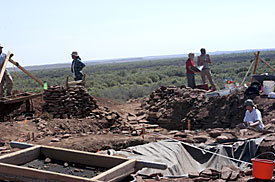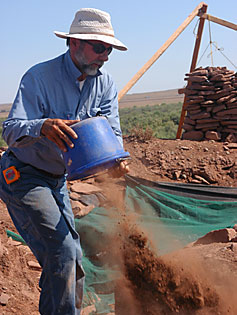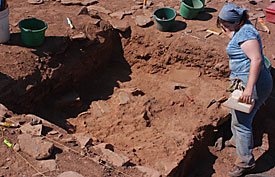 |
|
WILL SEBERGER/Arizona Summer Wildcat
|
Workers dig to unveil Pima tribe ruins at the Chevelon archaeological near Winslow.
|
|
By Cara O'Connor
Arizona Summer Wildcat
Wednesday July 9, 2003
Arizona State Museum archaeologists piece together an era in the state's history
The land surrounding Winslow, Ariz. seems desolate to most, as they zip along I-40 in the four corners region. But those that look a little closer might see a gateway to the past.
The Little Colorado River, which used to flow constantly in the region, is now dry, only bringing water to the area a few months each winter as the snow melts. It seems the area's only perk is the spectacular sunsets ÷÷ and even those are just products of light reflecting off of the dry sands of Great Basin Desert Grassland.
There, about 500 adobe-walled rooms once adorned a lonely butte, all part of an ancient city arranged in a half-circle formation.
That was Chevelon, an ancient American Indian village.
Today, a crew of Arizona State Museum archaeologists, University of Arizona graduate students and volunteers is excavating the Chevelon ruins as part of the Arizona State Museum's Homol'ovi Research Program. They are working to explain the ties between the people who inhabited Chevelon and the inhabitants of other ancient villages in the region.
There are many mysteries about the village that UA archaeologists have explored this summer since June 1.
One of those mysteries involves a series of fires that burned through more than 100 of the 500 rooms in the pueblo when it was inhabited between the year 1280 and 1380.
The Hopi people traditionally burned or buried kivas, underground ceremonial rooms, when they abandoned a settlement, but archaeologists at Chevelon found that rooms used for living, cooking and storage were also burned.
The crew discovered that even after the village was burned multiple times, people still returned to live there.
The burnings were probably intentional, Lange said.
While disaster is a possibility, it is a slim one ÷ structures made from adobe mud and stone masonry do not burn easily. For the team, this raises the questions: Who burned the pueblo? Did the Chevelon people abandon the village only to return later, or were they driven out by attackers?
 |
|
WILL SEBERGER/Arizona Summer Wildcat
|
Chuck Adams, project coordinator, helps to bail dirt from a room being excavated at the Chevelon site.
|
|
Protecting history
Finding the answers to these questions will take several additional years of excavation, two more years of which HRP already has funding for. A $230,000 grant from the National Science Foundation and support from Earthwatch, an organization that matches volunteers from the
general public with researchers, will keep HRP going through 2005.
HRP has been working in the Winslow area since 1984.
By that time, word that pothunters and looters had vandalized the ruins had peaked the concerns of the Hopi people, archaeologists and politicians, including Bruce Babbitt, the Arizona governor at the time.
"Homol'ovi was hit really hard by illegal collectors," said Karen Berggren, the park manager at Homol'ovi Ruins State Park, which was established in 1986 in part to protect the sites from vandalism.
On the black market, ancient Native American ceramics can be sold for tens of thousands of dollars and are especially popular among German and Japanese collectors, Lange said.
But when pothunters vandalize a site, they not only take valuable ceramics, but also destroy the sites for researchers by mixing layers of soil, moving and removing artifacts and damaging structures.
"Probably 75 to 80 percent of the information that we could have collected was lost," Berggren said.
In the late nineteenth century, Mormon settlers used stones from the ruins to build the town of Brigham City, Ariz., destroying huge amounts of archeological data. But in the 20th century, pothunters caused the most damage.
In the 1960s one pothunter was audacious enough to bring a backhoe to dig up the site, Berggren said. The pueblo's vicinity to main roads near the town of Winslow, as well as local knowledge of the site, made it especially susceptible to vandalism, she said.
But since the site became a park, the looting has come to a dead halt.
Now the 4,600-acre park is visited by nearly 20,000 visitors each year, all of whom now have the opportunity to see what vandals were not able to take.
"We get a lot of families who are traveling on I-40, but we also get a lot of people who are specifically interested in archaeology and anthropology. So we have a lot of really knowledgeable people," Berggren said.
In the park, visitors can see the remains of old pit houses, the earliest settlements in the area, along with a few excavated rooms and a large kiva.
Among the rocks on the buttes (Homol'ovi means "place of little buttes" in Hopi) visitors can find pieces of ancient pots, and walking through the park visitors might find small collections that other visitors have sorted by color and shape laying atop flat stones.
At the entrance of the park is a reminder to visitors: "Take nothing but photographs. Leave nothing but footprints," a reaffirmation of the park's purpose, to preserve sacred ruins.
 |
|
WILL SEBERGER/Arizona Summer Wildcat
|
Samantha Rubinson inspects an unearthed dwelling she helped to excavate.
|
|
A strict society
These ancient sites are home to many sacred Hopi shrines and structures, at which archaeologists have been able to document the beginnings of the Kachina religion, helping to piece together parts of the culture's history.
While the older villages in the park show no traces of the Hopi Kachina religion, archaeologists have found strong evidence of Kachina presence in Homol'ovi II, the last inhabited village in the area.
The layout of Homol'ovi II includes three large plaza spaces that would have been used for ceremonies and dances in addition to more than 40 kivas used for ceremonial purposes, Lange said. Petroglyphs of Kachina figures on rocks surrounding the village and murals on kiva walls also suggest Kachina worship.
Another indication of kachina worship was the presence of painted kachina figures on ceramic vessels. Lange called these images "the baseball cards of prehistory."
Kachinas are regarded as the spirits of the Hopi ancestors. The Hopi believe that these spirits spend half of the year in the underworld and the other half among the people in the pueblos. The Hopi people believe that the Kachinas help bring rain for their crops, but are also ╬social enforcers', Lange said.
During ritual dances, Kachinas reward upstanding Hopi people for their integrity and mock the bad behavior of others.
"It is an interesting system of control," Lange said.
That system of control is evident in other relics that archeologists have found at the ruin, as well.
Ritual burnings and coverings of kivas were customary. In these burnings archaeologists have found that bones and crystals were often placed in the ventilation shafts and ceramic vessels were placed in the corners before the kiva was burned, Lange said.
Associated with these burning rituals archaeologists found "at least two instances of some pretty severe social consequences," Lange said.
In the first instance archeologists uncovered the remains of three individuals in a covered over kiva: One young woman who was missing half of her right leg, one young man and a juvenile whose sex was unidentifiable.
It appears that the three were thrown into the kiva (archaeologists do not know whether they were dead or alive at the time) and covered in rocks before the kiva was ritually covered over in dirt.
In the second instance, a man was shot in the torso with arrows as he was presumably chased into the kiva, which was subsequently burned. Archaeologists found the man with his head in the ventilation shaft, trying to get fresh air as the kiva burned.
The village people sacrificed entire structures for the sake of punishing these people, Lange said.
These incidents show how Kachina religion and ritual were used to enforce societal expectations.
Piecing together the puzzle
Ceramics have played a large role in understanding the connections between indigenous peoples in the Southwest. The ratios of various types of pottery at a site are often strong indicators of trade connections and the art on the ceramics denotes certain religious beliefs.
At Chevelon, archaeologists found more than 10 times the amount of White Mountain red ware pottery than was present at any of the six other Homol'ovi sites, suggesting that Chevelon may have been home to immigrants from the White Mountains, Lange said.
The mix of adobe and stone masonry architecture and the curvilinear "D"-shaped layout of the site also suggest Zuni and Rio Grande-area influence in the Chevelon pueblo, Lange said.
Through the distribution of ceramic artifacts, the team has been able to establish a common bond among Homol'ovi villages.
That common bond is yellow ware pottery, which appeared in the early 1300s and quickly dominated the area.
Yellow ware ceramics were far more durable than the local pottery because, instead of wood, coal was used to fire the vessels, meaning the ceramics were fired at a much higher temperature.
Scientists at the Smithsonian Institution have traced the source of the yellow clay used to make the pots to the area surrounding the Hopi village of Awotovi, about 60 miles north of Homol'ovi.
This summer's excavation draws to a close on Saturday. The centuries-old rooms that were unearthed this summer will all be covered back over until researchers return next summer. But even when the team returns home, its members will take with the memories of what they unearthed in Chevelon.
For anthropology graduate students Lisa Gavioli and Ryan Howell, the summer was a success. Gavioli excavated what turned out to be a piki room, designed for cooking piki bread ¸ traditional flat Hopi bread.
Howell uncovered one of the largest rooms on the site and had two of the artifacts he unearthed displayed in museums. The function of his room remains a mystery, just as many other parts of Chevelon do.
And regarding the questions about the fate of the Chevelon people, Lange said: "The answer is more questions."
Until next summer, when those mysteries can be further investigated, there are artifacts to restore, measurements to study, and pollen samples to analyze. Every shard of pottery and ash deposit serves as a clue that may provide insight into the story of the people that once lived in these centuries-old rooms.

